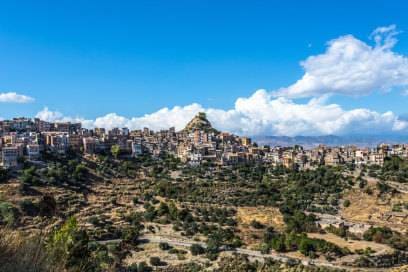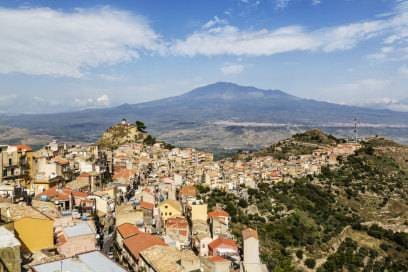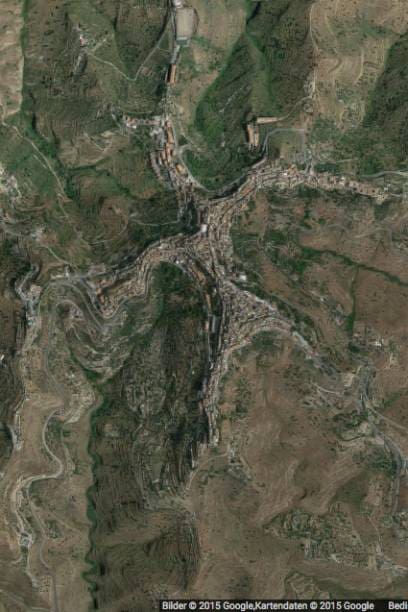September 2, 2024, 3:57 pm | Read time: 4 minutes
The village of Centuripe in Sicily gives rise to all kinds of speculation because, when viewed from above, it has a shape that can be seen nowhere else. What is behind it? TRAVELBOOK went in search of clues.
Centuripe is one of several dozen ancient villages in the interior of Sicily. It has a church, a few ruins from Roman times, and an archaeological museum. Its inhabitants primarily rely on agriculture and ceramic production for their livelihood. The nearest major town is 60 kilometers away. So far, so unspectacular. Outside of Sicily, few people, perhaps except archaeology enthusiasts, would take notice of the community of 5,500 inhabitants in the province of Enna. And yet Centuripe regularly appears in the media and causes discussion online.
More precisely, it is photos of Centuripe that are causing all kinds of speculation. The curiosity centers on the unusual shape of the village. The shape is revealed primarily from a bird’s eye view. The houses are built on several narrow ridges that extend star-shaped into the landscape at over 700 meters above sea level. Stella marina, starfish, is what some have christened Centuripe. Others see the shape more as a reclining person with outstretched arms. Yet others specify it resembles a sleeping old man. With some imagination, one could even see Centuripe as a winged dragon or a long-necked bird.
How Centuripe got its shape
Of course, the first settlers of Centuripe had neither a starfish nor birds or anything else in mind when they settled in the mountainous region. The origins of the village reach far into the past. The Sicans, one of the ancient peoples of Sicily, are believed to have lived here as early as around 2000 BCE. Later, around 500 BC, the Greeks colonized the island and gave the place the name Kentoripa. After the Roman conquest in the 3rd century BC, the mountain village became a flourishing town and strategically important point in the interior of the island of Sicily.
Centuries of conquests and misfortunes followed before the village was completely destroyed in the 13th century. It fell into oblivion until the 16th century. When a severe earthquake struck Sicily in 1408, and Mount Etna erupted, numerous families from the Catania region fled to the area and established new homes in the remains of Kentoripa. It was not until 1548 that the municipality was officially re-established under the name of Centorbi. It had around 800 inhabitants at the time.

Centuripe experienced its most significant boom and population increase at the beginning of the 20th century. At this time, sulfur was mined extensively in the area. Around 1920, the town had roughly 15,000 inhabitants, more than ever before. It was probably during this time that the buildings expanded outwards, following the orographic structures of the terrain. At least, that’s what you can read on Centuripe’s official municipal website. However, shortly after this period of prosperity, a decline ensued. This was due to the sulfur crisis in Sicily, which had been the world’s largest exporter of the element until then. The miners and their families left Centuripe. By 1926, the town’s population had dwindled to only 5,000 inhabitants—about the same as today.

Why Visiting Taormina Is Only Partially Worthwhile

Why the Maremma in the South of Tuscany is Definitely Worth a Visit

Ostuni — an Insider Tip in the South of Italy
Why it’s worth a visit
Even without the chance to marvel at Centuripe’s wondrous shape from above during a Sicilian vacation, visiting the ‘starfish town’ is still worthwhile. The two-story houses are built close to the hillside, interspersed with narrow alleyways, and Mount Etna, Europe’s highest and most active volcano, majestically rises behind the town. The small chapel perched high above the village on a hill is particularly pretty. Also worth seeing are the 17th-century Madre Immacolata Concezione parish church and the remains of the 17th-century town wall.

Then, there are the many excavation sites that bear witness to Roman times: a necropolis, a temple, a thermal bath, and a Roman house from the 2nd century with mosaics.
In the Archaeological Museum, visitors can admire vases, statues, and terracotta sculptures from the time of the ancient Greeks and Romans discovered during the excavations. However, the most important pieces are in larger museums in various Italian cities, some even in Paris, London, New York, and Berlin.
For those wishing to extend their stay, Centuripe offers a hotel with an adjoining restaurant that has received very favorable reviews on TripAdvisor. You can find other well-rated hotels in the area here.


